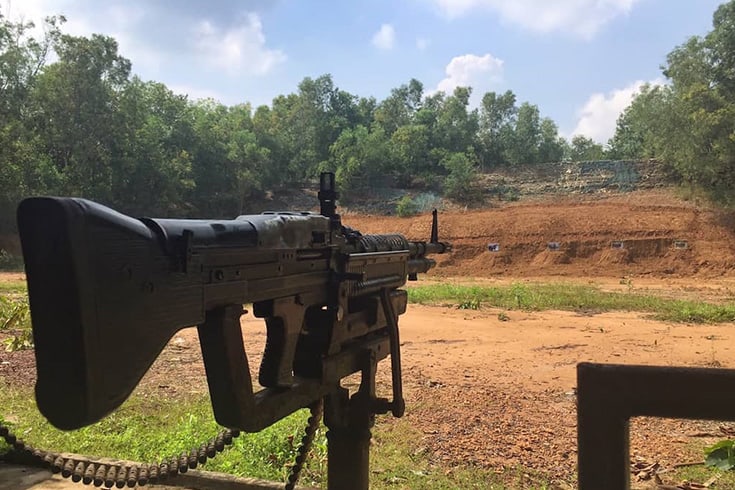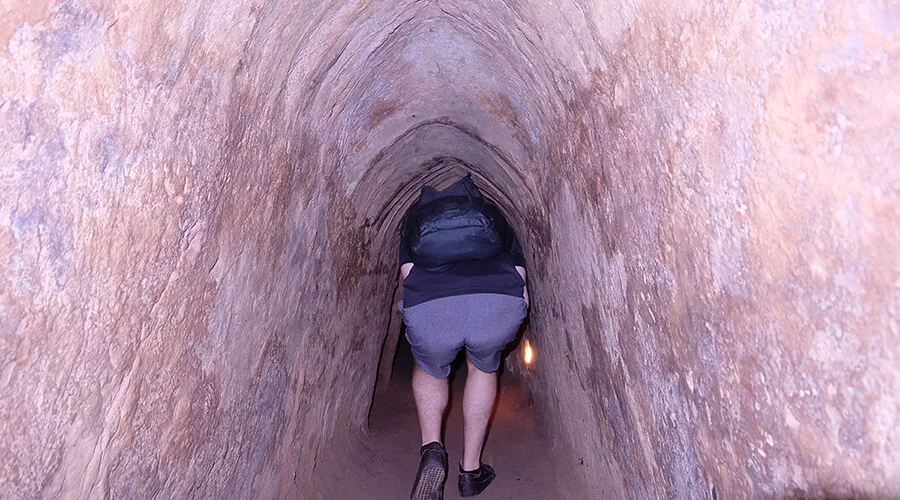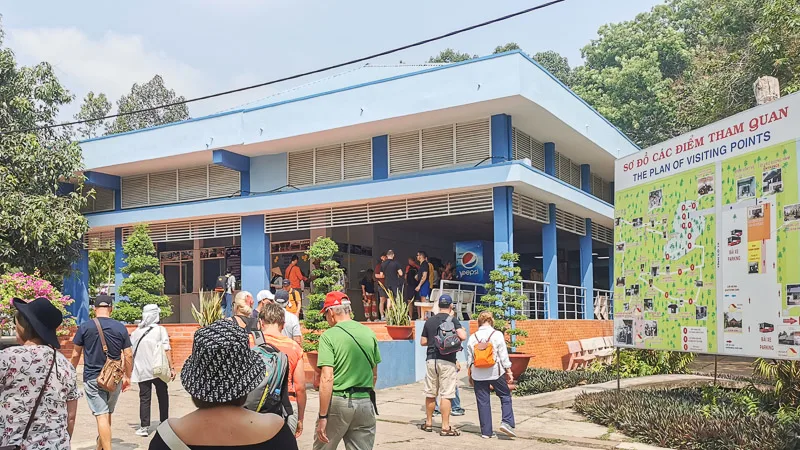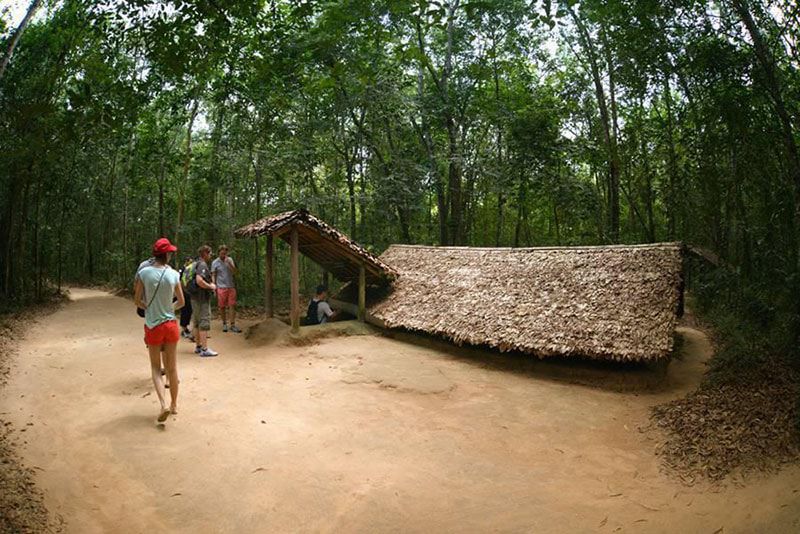Table of Contents
In the heart of southern Vietnam, concealed beneath lush vegetation, lies a remarkable subterranean marvel – the Cu Chi Tunnels Ben Dinh. This intricate network of underground passages, bunkers, and chambers served as a pivotal stronghold for Vietnamese forces during the Vietnam War. Extending over 250 kilometers, the tunnels provided a clandestine haven, enabling guerilla warfare tactics and contributing significantly to the country’s ultimate victory.
The Cu Chi Tunnels Ben Dinh hold a significant place in Vietnamese history, representing the resilience and strategic ingenuity of the Vietnamese people. In this article, we will delve into the rich history and fascinating features of these two sites, exploring their impact on the Vietnam War and the local community. So, put on your explorer’s hat and join us on a journey through the labyrinth of secrets hidden within the Cu Chi Tunnels and Ben Dinh.
History of Cu Chi Tunnels
The origins of the Cu Chi Tunnels can be traced back to the 1940s when they were initially built as a refuge for local villagers seeking shelter from French colonial forces. However, it wasn’t until the Vietnam War that the tunnels gained widespread recognition for their crucial role in the conflict.
During the war, the Cu Chi Tunnels Ben Dinh served as a base for the Viet Cong, a communist guerrilla force fighting against the South Vietnamese government and its allies. The tunnels provided a safe haven for the Viet Cong, allowing them to launch surprise attacks on their enemies and retreat quickly without being detected.
Location of Ben Dinh in Vietnam

Ben Dinh is a small village located in the Cu Chi district of Ho Chi Minh City, formerly known as Saigon. It is situated amidst verdant rice paddies, making it an ideal location for concealing the intricate network of tunnels that lie beneath its surface.
The village is approximately 70 kilometers northwest of Ho Chi Minh City, and it takes about an hour and a half to reach by car. The nearby Cu Chi district is also home to other historical sites such as the Cao Dai Temple and the War Remnants Museum, making it a popular tourist destination.
Importance of Cu Chi Tunnels in the Vietnam War

The Cu Chi Tunnels played a crucial role in the Vietnam War, providing a strategic advantage to the Viet Cong forces. The tunnels were used for various purposes, including living quarters, supply routes, hospitals, and weapon caches. They also served as a communication network, allowing the Viet Cong to coordinate their attacks effectively.
The tunnels were a constant source of frustration for the American and South Vietnamese troops, who struggled to combat the guerilla warfare tactics employed by the Viet Cong. Despite numerous attempts to destroy the tunnels, they remained a significant stronghold for the Viet Cong throughout the war.
Construction and Design of Cu Chi Tunnels

The construction of the Cu Chi Tunnels Ben Dinh was a remarkable feat of engineering, with most of the work being done manually by the Vietnamese soldiers. The tunnels were dug using simple tools such as shovels, hoes, and bamboo picks, and the soil was carried away in baskets or bags.
The tunnels were designed to be narrow and low, measuring only 60-80 centimeters in height and 70-90 centimeters in width. This made it difficult for larger soldiers to enter and navigate through them, giving the Viet Cong a significant advantage.
The tunnels were also equipped with various traps and obstacles to deter and harm any enemy soldiers who managed to enter. These included spike pits, camouflaged trapdoors, and booby traps made from explosives or sharpened bamboo stakes.
Life inside the Cu Chi Tunnels

Life inside the Cu Chi Tunnels Ben Dinh was challenging and dangerous, with soldiers facing constant threats from enemy attacks, disease, and lack of resources. The tunnels were dark, cramped, and infested with insects and vermin, making living conditions extremely uncomfortable.
The soldiers had to be resourceful and innovative to survive in the tunnels, using whatever materials they could find to make their lives more bearable. They built kitchens, sleeping quarters, and even classrooms within the tunnels, where they would receive training on various weapons and tactics.
Despite the harsh living conditions, the soldiers remained resilient and determined, driven by their unwavering commitment to their cause. Their bravery and sacrifice played a significant role in the ultimate victory of North Vietnam over South Vietnam and its allies.
Tourism at Cu Chi Tunnels and Ben Dinh

Today, the Cu Chi Tunnels and Ben Dinh have become popular tourist destinations, attracting visitors from all over the world. Tourists can explore a small section of the tunnels that have been widened and reinforced for safety purposes. They can also visit the nearby Ben Dinh village, where they can learn about the history and culture of the area.
Tourism has brought economic benefits to the local community, providing job opportunities and boosting the economy. However, it has also raised concerns about the preservation of the historical site and the impact of tourism on the environment and the local way of life.
Impact of Cu Chi Tunnels on the Local Community

The Cu Chi Tunnels Ben Dinh have had a significant impact on the local community, both during the war and in the present day. During the war, the tunnels provided shelter and protection for the villagers who lived in fear of bombings and attacks. They also served as a source of food and supplies for the villagers, who were often cut off from the outside world due to the ongoing conflict.
Today, the tunnels and the nearby village have become a source of income for the locals, who offer tours and sell souvenirs to tourists. However, the influx of visitors has also brought about changes in the community, with some villagers being forced to relocate to make way for tourism development.
Facts and Figures about Cu Chi Tunnels and Ben Dinh

- The Cu Chi Tunnels extend over 250 kilometers, making it one of the longest underground systems in the world.
- The tunnels were used by an estimated 16,000 Viet Cong soldiers during the Vietnam War.
- It is believed that over 45,000 Vietnamese soldiers lost their lives in the Cu Chi Tunnels during the war.
- The tunnels were first discovered by American soldiers in 1966, but they were unable to destroy them completely.
- In 1988, the tunnels were opened to the public as a tourist attraction, and today, they receive over a million visitors each year.
Comparison between Cu Chi Tunnels and other Underground Systems
The Cu Chi Tunnels are often compared to other underground systems around the world, such as the Catacombs of Paris and the Underground City in Beijing. While these systems share similarities in terms of their purpose and design, the Cu Chi Tunnels stand out for their historical significance and the role they played in a major conflict.
Unlike the Catacombs of Paris, which were primarily used for burial purposes, the Cu Chi Tunnels were built for military purposes. Similarly, while the Underground City in Beijing was designed to serve as a refuge during times of war, the Cu Chi Tunnels were used for both shelter and combat.
Future of Cu Chi Tunnels and Ben Dinh

As tourism continues to grow in Vietnam, the future of the Cu Chi Tunnels and Ben Dinh remains uncertain. There are concerns about the preservation of the historical site and the impact of tourism on the local community and environment.
Efforts are being made to balance the preservation of the tunnels with the needs of tourism, such as limiting the number of visitors and implementing sustainable practices. It is essential to find a balance between preserving the historical significance of the Cu Chi Tunnels and supporting the local community through responsible tourism.
Conclusion
The Cu Chi Tunnels Ben Dinh are not just a tourist attraction; they hold a significant place in Vietnamese history and represent the resilience and determination of the Vietnamese people. These underground systems served as a crucial stronghold during the Vietnam War, contributing to the ultimate victory of North Vietnam over South Vietnam and its allies.
Today, the Cu Chi Tunnels and Ben Dinh continue to fascinate and educate visitors about the country’s past. As we navigate through the labyrinth of secrets hidden within these tunnels, let us remember the sacrifices made by the soldiers who fought for their cause and the impact of war on the local community.